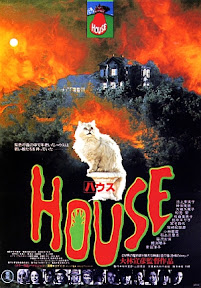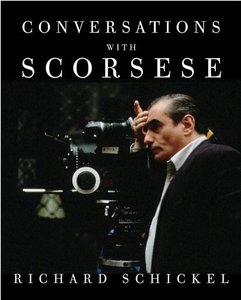 On the box cover, the Criterion Collection tries to prepare viewers for Nobuhiko Obayashi's film by describing it as "a Scooby-Doo episode directed by Mario Bava." I can do better than that. Think instead of Suspiria directed by Sid & Marty Krofft and you get closer to the actuality of House, and I mean that in a "best of both worlds" way. That's not to say I'm the biggest fan of either the Kroffts or Dario Argento, but the work of each has its virtues, and Obayashi's movie will remind those who know of both. For about the first fifteen minutes, however, my reaction was, "What the hell am I watching?" How else can you react to such deliberate cheesiness? I assumed that Obayashi was sending up something, presumably the Japanese teen-girl culture of the Seventies and the sorts of TV shows it favored. But without a firm frame of reference I could just as easily assume that Obayashi is a madman with an idiosyncratically offputting aesthetic sense. In one sense, he is a madman; House was his feature-film debut after a career as a cutting-edge director of commercials. Anywhere on earth, probably, you're playing with fire letting such a person make a feature. But such was Obayashi's reputation, I assume from the trailer, that Japanese audiences were expecting something profoundly weird.
On the box cover, the Criterion Collection tries to prepare viewers for Nobuhiko Obayashi's film by describing it as "a Scooby-Doo episode directed by Mario Bava." I can do better than that. Think instead of Suspiria directed by Sid & Marty Krofft and you get closer to the actuality of House, and I mean that in a "best of both worlds" way. That's not to say I'm the biggest fan of either the Kroffts or Dario Argento, but the work of each has its virtues, and Obayashi's movie will remind those who know of both. For about the first fifteen minutes, however, my reaction was, "What the hell am I watching?" How else can you react to such deliberate cheesiness? I assumed that Obayashi was sending up something, presumably the Japanese teen-girl culture of the Seventies and the sorts of TV shows it favored. But without a firm frame of reference I could just as easily assume that Obayashi is a madman with an idiosyncratically offputting aesthetic sense. In one sense, he is a madman; House was his feature-film debut after a career as a cutting-edge director of commercials. Anywhere on earth, probably, you're playing with fire letting such a person make a feature. But such was Obayashi's reputation, I assume from the trailer, that Japanese audiences were expecting something profoundly weird. Thanks in part to the director's daughter, who contributed story ideas, that's exactly what everyone got. House (which is the film's original Japanese title, spoken in one's best spooky voice) is the story of two teenage girls, Gorgeous and Fantasy, and their trip with five friends to Gorgeous's aunt's house. Gorgeous lives in a world of blazing colors, artificial skies, and a suspicious new stepmother her dad picked up on the way back from a movie-scoring gig for Sergio Leone in Italy. Eager to steer clear of her new mom, Gorgeous gathers her pals -- Fantasy, Mac (the fat one), Sweet (the helpful one who loves cleaning), Melody (the musical one), Kung Fu (self-explanatory) and Prof (ditto) -- to visit her poor crippled aunt, still pining for her lost lover, a WWII flier (shown in silent-film style footage), after all these years. Normally Auntie has only her ubiquitous white cat Blanche for company. But she brightens up as soon as Gorgeous and her friends show up -- and start disappearing. And soon she's on her feet and dancing, and jumping into refrigerators. Initially, only the tragically-named Fantasy suspects that something's very wrong, but a horror soon emerges that nobody can deny.
House soon turns into a special kind of gorefest. Obayashi isn't aiming for the visceral shocks of his horror-film contemporaries. Instead, he evokes the uncanny in cartoonish ways that underscore the magical nature of the menace threatening the girls. If someone's dismembered, her limbs fly around a room for a while, sometimes retaining some life of their own. The effects have a cut-and-paste look that somehow seems exactly right for the sort of film he made. Those alienating early scenes of deliberate fakery were really building blocks of a unique cinematic idiom into which Obayashi could translate genuine terror while remaining faithful to his corny source-aesthetic. While for someone else the gag might have been to destroy these silly girls with realistic violence and gore, for Obayashi the point was to tell a tale of primal horror (with not a few hints of pubescent rites-of-passage) the way a 13 year old girl raised on TV and manga might envision it. Against all odds, it works, even as Obayashi schemes constantly to break the mood with the cat's silly dance across a keyboard, Kung Fu's outbursts of frenetic action (she has her own authentically cheesy soundtrack motif) and occasional cutaways to the desultory trek of Mr. Togo, the girls' hoped-for savior, toward the dreaded house. Despite it all (and perhaps despite is the wrong word) the cumulative effect is honestly horrific, and the coda ("When my friends wake up, they're hungry") is indisputably chilling.
In House the horror leaps up and bites you in the ass -- literally. It may also literally chop your fingers off, so use House with caution and only after reading the instructions carefully.
While House proved a sleeper hit in Japan, it never played American theaters until the 21st century. I suspect, though, that Obayashi had influence beyond his home islands. It wouldn't surprise me, for instance, if House had some influence on Peter Jackson's early films, since Kung Fu's climactic battle with ghostly forces reminded me slightly of some of the action in Dead Alive. Closer to home, I could believe that Obayashi's use of stop-motion and other gimmickry influenced later Japanese cult spectacles like Tetsuo the Iron Man. I guess I assume it had to have an influence on people because I can't imagine anyone forgetting House once they saw it. You might like it or hate it, but it'll probably be one of the damndest films you've ever seen one way or the other. This subtitled trailer will give you some idea of what Toho calls "the first fantasy horror film" Janusfilmsnyc uploaded this one to YouTube.











